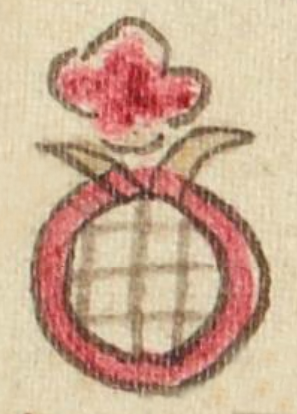Chimalxoch (Azca16)
This painted black-line drawing of the compound glyph for the personal name Chimalxoch (“Shield Flower”) is attested here as a woman’s name. It shows a frontal view of a war shield (chimalli) with a red flower (xochitl) on top. The flower has three visible petals. The circular shield has a red border and a mesh pattern inside the circle.
Stephanie Wood
The shield (chimalli) serves as a phonetic indicator for the sunflower (chimalxoch or chimalxochitl). The artist does not try to depict a yellow sunflower. This is the first sunflower glyph in the collection as of May 2025. Also, at this time, a shield with a mesh pattern is rare in this collection. The contextualizing image shows that the woman named Chimalxoch has been taken captive. She wears only a skirt. The warrior who has captured her is holding her by her hair. Interestingly, Chimalxoch is the name of a Nahua princess who was born before 1299 C.E. She was the daughter of the elder Huitzilihuitl (see Wikipedia). It may be this very woman who is being depicted here. Her sister Tozpanxoch was also captured in this scene, as was their father, Huitzilihuitl. The captors were the Xaltocameca.
Stephanie Wood
Chimalxoch
Chimalxoch
Stephanie Wood
post-1550, possibly from the early seventeenth century.
Jeff Haskett-Wood
flores, girasoles, guerra, nombres de mujeres

chimal(li), war shield, https://nahuatl.wired-humanities.org/content/chimalli
xoch(itl), flower, https://nahuatl.wired-humanities.org/content/xochitl
chimalxoch(itl), sunflower, https://nahuatl.wired-humanities.org/content/chimalxochitl
Escudo-Flor
Stephanie Wood
The Codex Azcatitlan is also known as the Histoire mexicaine, [Manuscrit] Mexicain 59–64. It is housed in the Bibliothèque Nationale de France, and hosted on line by the World Digital Library and the Library of Congress, which is “unaware of any copyright or other restrictions in the World Digital Library Collection.”
https://www.loc.gov/resource/gdcwdl.wdl_15280/?sp=16&st=image
The Library of Congress is “unaware of any copyright or other restrictions in the World Digital Library Collection.” But please cite Bibliothèque Nationale de France and this Visual Lexicon of Aztec Hieroglyphs.








